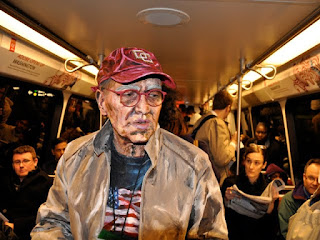We started our meeting by discussing the themes we see in the present collection. Mara said that she saw identity in all the pieces as well as process -- particularly in the Meyers piece as well as the many layers of the Pinder installation.
David agreed that identity was present in all the pieces as well as the theme of perception, the way we view things. He added that even in the excavation photograph there is evidence of what is human-made.
Erin added that many of the pieces seems to deal with the permeability of cultural boundaries and ways in which we create our own identities. She also said that as a viewer, she initially looks for form and aesthetic considerations before theme, making the exercise particularly interesting to her.
Maya said that one of the hallmarks of contemporary art is the consideration of what the viewer brings to what she's looking at.
Eldis added that many of the current pieces address the question of technology and its effects. He agreed that cultural identity is another common theme, but added that perhaps the collection could better address gender and sexual identity.
Erin responded that many of the cultural identity pieces in the present collection have similar approaches, i.e. "I am not what you think I am."
David said he saw themes of assumption in a lot of the work.
Maya wondered about finding pieces that are deeply prideful of cultural identity, to which Erin responded with a few artists who are bringing together images from various cultures as means of celebrating cultural hybridity. She referenced a few specific artists and we spent some time looking at work by Yinka Shonibare, Lalla Essaydi, Kehinde Wiley, and Grace Ndiritu (see images below).
As a result of this discussion, we came up with the following themes to explore:
Gender/sexuality
Culture as hybridity
Discovery
Place/setting/location
Time/timeliness
Growth/journey/transformation
Art as a reference to the tradition of art
Identity formation
Environmentalism/organic movement/nature
Questioning authority
More overt political themes
How UMD's environment shapes students
Civic engagement
Social responsibility
UMD's involvement in the local community
Pieces exploring non-humanities disciplines (science, mathematics, etc.)
High culture vs. low culture
Religion
Religious diversity
Erin added that all the work in the collection is very cerebral and that there is very little work about work. "Contemporary art doesn't have to be ugly," she said.
David added that he is hoping for something three-dimensional in the collection, and Maya added that the presence of other genres would strengthen the collection overall.
Yinka Shonibare
Lalla Essaydi
Kehinde Wiley
Grace Ndiritu



















